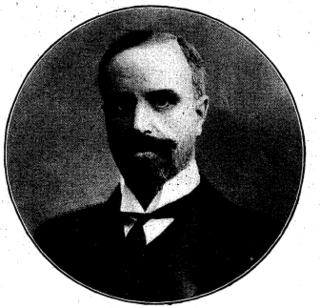
His Hon. Thomas Bateman Napier LLD (1854-6 November 1933), was a British Liberal Party politician and judge.

His Hon. Thomas Bateman Napier LLD (1854-6 November 1933), was a British Liberal Party politician and judge.
He was a son of Richard Clay Napier of Preston, and Sarah Bateman of Salford. He was educated at Rugby School and London University. He married first in 1882, Florence Emily Roberts of Upminster, who died in 1915. They had one son who was killed in the Great War, and two daughters. He married second in 1917, Mrs Amy Julia Tootal who died in 1923. [1]
During his student days he gained the Incorporated Law Society's Clifford Inn Prize, and Scot. Scholarship, and the Council of Legal Educated's first class International and Roman Law Exhibition, and other law scholarships and prizes. He took a first class in Law at the University of London; honours at Bar Call. Examination. He was elected Fellow and Member of Senate, University of London, in 1895. He became a Justice of the Peace in Middlesex, 1895. He wrote a Concise Practice of the Supreme Court of Justice; The New Land Taxes, 1909–1910. He became Judge of County Courts, in Derbyshire, in 1912. [2]
He was a Member of the London County Council from 1893 to 1906. [3] He contested Islington North as a Liberal candidate in 1895. He was twice Chairman of Corporate Property, and three times Chairman of Parliamentary Committee, of the London County Council. He sat as Liberal MP for the Faversham Division of Kent from 1906 to 1910. He had gained the seat from the Conservatives at the 1906 General Election
| Party | Candidate | Votes | % | ±% | |
|---|---|---|---|---|---|
| Liberal | Thomas Bateman Napier | 6,925 | 57.6 | n/a | |
| Conservative | John Howard | 5,091 | 42.4 | n/a | |
| Majority | 1,834 | 15.2 | n/a | ||
| Turnout | n/a | ||||
| Liberal gain from Conservative | Swing | n/a | |||
but lost it to them at the next General Election in January 1910.
| Party | Candidate | Votes | % | ±% | |
|---|---|---|---|---|---|
| Conservative | Granville Charles Hastings Wheler | 7,438 | 58.0 | +15.6 | |
| Liberal | Thomas Bateman Napier | 5,394 | 42.0 | -15.6 | |
| Majority | 2,044 | 16.0 | 31.2 | ||
| Turnout | 87.6 | ||||
| Conservative gain from Liberal | Swing | +15.6 | |||
He did not stand for parliament again. [4] He was a co-opted Member of the London Educated Committee, 1915. He became a Governor of Rugby School, in 1927. [5]

Ernest Evans was a Liberal Party politician from Wales.

Alfred Emmott, 1st Baron Emmott, was a British businessman and Liberal Party politician.
Finsbury East was a parliamentary constituency centred on the Finsbury district of North London, England. It returned one Member of Parliament (MP) to the House of Commons of the Parliament of the United Kingdom, elected by the first past the post system.

Charles Henry Roberts was a British radical Liberal politician.

Eugene Wason was a Scottish lawyer and Liberal politician who sat in the House of Commons in three periods between 1885 and 1918.

John William Wilson, PC, JP was a British chemical manufacturer and politician who served for 27 years as a member of parliament (MP), initially as Liberal Unionist and then as a Liberal.

Rt Hon. Sir Daniel Ford Goddard PC JP was a British civil engineer, businessman and Liberal Party politician who served as a Member of Parliament (MP) for Ipswich from 1895 to 1918. He was also Mayor of Ipswich from 1891 to 1892.

Edward Alfred Goulding, 1st Baron Wargrave, known as Sir Edward Goulding, Bt, between 1915 and 1922, was a British barrister, businessman and Conservative Party politician. He sat in the House of Commons between 1895 and 1922, before being ennobled and taking his seat in the House of Lords.

Henry Greville Montgomery was a British Liberal Party politician, newspaper proprietor, and leading figure in the brickwork business. He was the Member of Parliament (MP) for Bridgwater from 1906 to 1910.
The Barnstaple by-election was a Parliamentary by-election. It returned one Member of Parliament (MP) to the House of Commons of the Parliament of the United Kingdom, elected by the first past the post voting system.
The West Ham North by-election was a Parliamentary by-election which was held in 1911. It returned one Member of Parliament (MP) to the House of Commons of the Parliament of the United Kingdom, elected by the first past the post voting system.
The 1912 Carmarthen District by-election was a Parliamentary by-election held in the United Kingdom on 29 January 1912 for the Carmarthen District in Wales. The constituency of Carmarthen District of Boroughs, was centred on the boroughs of Carmarthen and Llanelli. It returned one Member of Parliament (MP) to the House of Commons of the Parliament of the United Kingdom, elected by the first past the post voting system.

Samuel Moss MA BCL JP CC MP, was a Welsh Liberal politician and judge.

His Hon. Henry Yorke Stanger, was a British Liberal Party politician and judge.

David Sydney Waterlow, was a British Liberal Party politician and businessman.

Sir Dudley Stewart-Smith was a British Liberal Party politician and barrister.

Thomas Arnold Herbert was a British Liberal Party politician and barrister.

William Henry Bateman Hope was a British Liberal Party politician.

Sir William Samuel Glyn-Jones was a British Liberal Party politician and pharmacist.
The Hartlepools by-election was a Parliamentary by-election. It returned one Member of Parliament (MP) to the House of Commons of the United Kingdom, elected by the first past the post voting system.